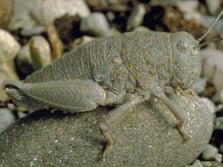Image gallery
Terrestrial invertebrates

Robust grasshopper Brachaspis robustus
Braided rivers are home to many land and water-living insects, spiders and other invertebrates. These invertebrates are an essential part of braided river food chains.
We don’t know enough about invertebrates in braided river beds. Some, like the robust grasshopper, are only found in the upper Waitaki Basin. This large distinctive grasshopper was originally only found in braided riverbeds but has recently been found on old terraces, away from the river channel itself.
Another threatened grasshopper endemic to the area, the much smaller alpine grasshopper Sigaus minutus, is also found in riverbeds.
Recent survey work in the Tasman riverbed has revealed four new terrestrial invertebrate species - a fly, bee, bug and beetle. Analysis of the samples is still underway but of the specimens identified to date, the greatest diversity of species is in the taxonomic orders Diptera (flies) and Hymenoptera (bees and wasps), whereas the most abundant order is the Collembola (springtails).
Aquatic invertebrates

Aquatic snail
All of the aquatic invertebrate groups found in New Zealand are represented in the Waitaki Basin’s braided rivers and associated wetlands.
This includes caddisflies, stoneflies, mayflies, dragonflies, damselflies, midges and other aquatic flies, snails, spiders and aquatic hemipterans (e.g. backswimmers and water boatmen).
Nationally uncommon species are also known to be present, such as the caddisfly, Psilochorema folioharpax, which has been found in the Tasman River.
Lizards

Southern Alps gecko
Braided riverbeds provide ideal habitat for lizards such as McCann’s skink/mokomoko which likes to use dry rocky areas for basking in the sun. The Southern Alps gecko can be found in riverbeds. The long-toed skink can be found on eroding river terraces.
Freshwater fish

Upland longjaw galaxias
Braided rivers and their associated wetlands are home to several fish species. The non-migratory bignose galaxias is only found in this region.
Two other non-migratory species are also present - the threatened lowland longjaw galaxias and upland longjaw galaxias.
Six other native freshwater fish can also be found in the upper Waitaki Basin – longfin eel/tuna, kōaro, Canterbury galaxias, alpine galaxias, upland bully and common bully.
River and wetland birds

Black-fronted tern/tarapirohe
The upper Waitaki Basin’s braided river systems are a stronghold for several of New Zealand’s most threatened birds:
- Wrybill/ngutu pare - its unique curved bill is highly specialised to survive in the braided river environment
- Black stilt/kakī - now only breeds in the upper Waitaki
- Black-fronted tern/tarapirohe
- Black-billed gull/tarāpunga
- Caspian tern
- Banded dotterel/turiwhatu

Australasian bittern/matuku-hūrepo
Other wading birds that can be found throughout the region’s braided rivers include:
- South Island pied oystercatcher/tōrea
- Pied stilt/poaka
The few remaining wetlands in the upper Waitaki Basin support nationally threatened or vulnerable wetland bird species like the Australasian bittern/matuku-hūrepo, the marsh crake/koitareke and the Australasian crested grebe/kāmana.
They also provide important habitat for a range of native waterfowl:
- Grey duck/pārera
- Grey teal/tete
- Paradise shelduck/pūtakitaki
- New Zealand shoveler/kuruwhengu
- Pūkeko
Wetlands are also used by Australasian harriers/kāhu, kingfisherskōtare, various cormorants (shags/kōau), white-faced herons and, occasionally, white herons/kōtuku and royal spoonbills/kōtuku-ngutupapa.